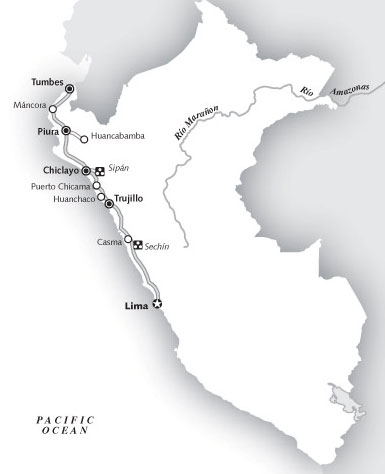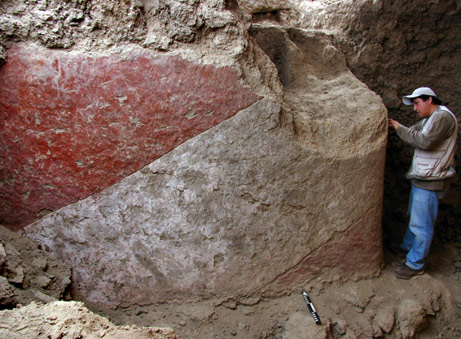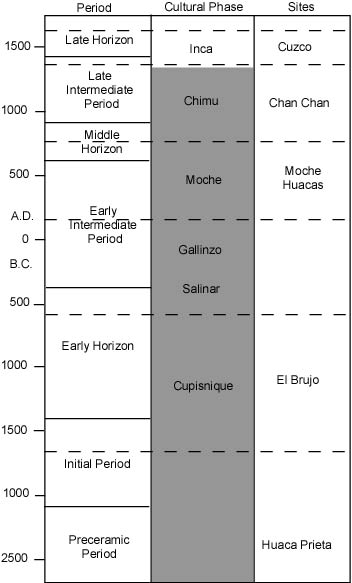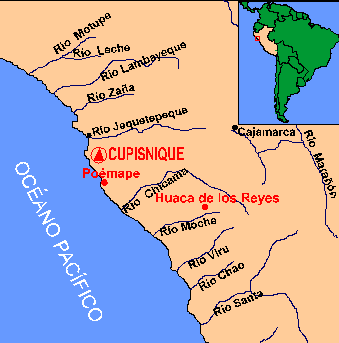3,000-Year-Old “Spider God” Temple Discovered in Peru
posted on January 14th, 2009 in Archaeology, Northern Kingdoms of Peru, Peru, Recent Discoveries
“Spider God” Temple Found in Peru
National Geographic News
October 29, 2008
A 3,000-year-old temple featuring an image of a spider god may hold clues to little-known cultures in ancient Peru.
People of the Cupisnique culture, which thrived from roughly 1500 to 1000 B.C., built the temple in the Lambayeque valley on Peru’s north coast.
The adobe temple, found this summer and called Collud, is the third discovered in the area in recent years.
The finds suggest that the three valley sites may have been part of a large capital for divine worship, said archaeologist Walter Alva, director of the Royal Tombs of Sipán Museum.
The Cupisnique culture stretched north and south of the modern-day city of Chiclayo in NW Peru
Alva and colleagues started the dig in November 2007, when they discovered a 4,000-year-old temple and a mural painting at the Ventarrón site in the valley. Both the temple and mural were the oldest ever found in the Americas.
The entire religious complex houses every ancient Peruvian architectural style up to the Inca, Walter Alva said, one of only a few sites in Peru that spans so many cultures.
Several Meanings
The spider-god image appears often in other sites created during Peru’s Early Formative Period, 1200 to 400 B.C.
For instance, the Garagay temple in Lima and the Limón Carro site in northern Peru both include the imagery, according to Ignacio Alva, Walter Alva’s son and colleague.
At the newfound Collud, the spider god carried several meanings, experts say.
The image combines a spider’s neck and head, the mouth of a large cat, and a bird’s beak, Ignacio Alva said.
The spider is also carved with lines radiating from its neck, creating a web-like appearance.
The web symbolizes hunting nets, a sign of human progress and prosperity, Ignacio Alva said. Traps set with nets caught more prey than spear hunting, he added.
The spider figure also had political significance, Ignacio Alva said. “Any emergent political group would have to be associated with this god.”
Richard Burger, an expert on the Chavin culture that followed the Cupisnique, first identified the spider deity in stone bowls found at the Limón Carro site.
The importance of spiders owed partly to their connection with life-giving rain, he said.
“They were associated with divination of rainfall because spiders come out before rain,” said Burger, an archaeologist at Yale University who was not involved with the Lambayeque excavation.
The spider deity was also associated with textiles, hunting, war, and power, Burger added. “There is an image of spider deities holding nets filled with decapitated human heads, so there was an analogy with successful warriors and claims of power.”
Intense Interaction
The Chavin people who came after the Cupisnique built a temple adjacent to Collud, Zarpan, about three hundred years later.
The new temple finds may help explain a cultural shift from Cupisnique to Chavin, said team leader Walter Alva.
Peru’s Cupisneque culture predated the Incas by more than 2,000 years
“Cupisnique and Chavin shared the same gods and the same architectural and artistic forms, showing intense religious interaction among the cultures of the [Early] Formative Period from the north coast to the Andes and down to the central Andes,” he said.
The temples are similar in size, roughly 1,640 feet (500 meters) long and 984 feet (300 meters) wide.
Collud has a monumental clay staircase with 25 steps, perhaps the inspiration for the later Zarpan temple’s clay staircase, Ignacio Alva said.
The Chavin did not build clay structures in the Andes, where significant rainfall threatened their stability.
But clay structures were typical of the Cupisnique culture, which developed on the arid north coast.
It’s unknown how the two cultures interacted, if at all, experts say.
“This place is the testimony of two cultures overlapping and will help clarify what is Cupisnique and what is Chavin,” Walter Alva said.
Mystery Decline
Pieces of structures found at the site may lead to the discovery of a fourth or fifth temple, according to the team.
Yale’s Burger wonders if the ongoing excavations will demonstrate what happened to the site as north-coast cultures declined between 900 and 700 B.C.
“The far north coast in earlier times was very important, but it has been largely ignored because there’s so little information,” Burger said. “This could change that.”
“Does this center continue to be important or does it collapse?” he asked. “Does the Cupisnique continue to flourish independently or in close contact with the Chavin?”
Ignacio Alva predicts the site will show that the temple complex transformed itself, but did not collapse.




